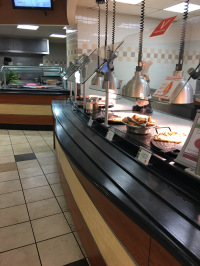The four dining companies involved in the Request for Proposals (RFP) process are Sodexo, Compass Group, Aramark Corporation and CulinArt Group, according to Deming Yaun, University Dining Contract Liaison. The proposals will now be due Feb. 19, instead of a previous Feb. 16 deadline.
In an interview with The Fordham Ram, Yaun said that the decision to terminate Sodexo’s contract was a mutual one.
“Its unfortunate that there have been some challenges and while some of those appear to have been resolving, we thought we really need to take a time out,” said Yaun.
Three of the four companies involved in the RFP process are in the top 50 largest U.S. foodservice management companies, according to a Food Management ranking released in 2012. Sodexo, Inc. is third, Aramark Corp. is second and Compass Group North America is the first largest.
CulinArt is a smaller company, operating out of Plainview, New York. Yaun had previously worked for Aramark and Sodexo, but was not familiar with CulinArt.
“CulinArt is new to me and very fascinating to work with,” said Yaun.
Sodexo’s contract with Fordham is to be terminated June 30, 2016. A contract from 2013 stipulated that if Sodexo had not removed itself from The Princeton Review’s “Is It Food?” rankings by August of 2016, the company would incur a $3 million financial penalty. Fordham’s dining services ranked 13 on that list this year.
Under this new agreement, Sodexo will avoid that penalty.
Yaun said that this was because of timing.
“Our fiscal year ends June 30,” said Yaun. “There is no good time, but it is just about the slowest point of the year, so if we brought in a new company, we want representatives on campus early if we make the change. We did not want to wait till June 30, 2017 for a renewed approach to Fordham dining. Those factors overrode our decision to stay to that commitment.”
Additionally, the timing of The Princeton Review surveys played a role. Fordham and Sodexo had made the 2013 contract anticipating The Princeton Review would publish in August 2016, according to Yaun.
“We are not going to be surveyed before August 2016,” Yaun explained. “At the time that date was selected, we were looking at being surveyed October 2015, with the results published in August 2016. They only publish once a year, so it made sense at the time. So we went for the early survey in February, because we were confident since our [internal survey] scores had gone up so high.”
“We did better, but we didn’t do as well as we would have liked.”
Sodexo might face smaller financial penalties due to other Key Risk Indicator goals, which include overall satisfaction, speed of service, friendliness of staff, ability to answer questions and customer knowledge of how to report feedback.
“We do have our annual scores that we agreed to last May on all of these criteria. Those add up to a much smaller penalty if they’re all enacted. But, they could incur a penalty for those,” said Yaun.
Yaun also discussed discrepancies between Fordham’s presence on the worst food list rankings and internal surveys depicting around an 80 percent satisfied or highly satisfied rate in Fordham students.
“Go back to 2012 when we were number one on the worst food list. Our internal scores of overall satisfaction, students responding satisfied or highly satisfied, was four percent. So we matched, totally. We got up into the sixties in the subsequent years, and then the eighties. The Princeton Review does surveys every three years. So the only way we went from one to seven is that other schools came in worse.”
Yaun had questions regarding The Princeton Review’s survey mechanisms.
“Do they add new data to the old data, or are they just shoving out the old data and using the new?” Yaun said. “My guess is they’re adding it to the old, because how can there be this discrepancy. But, thats the thing that is public.”
An explanation on The Princeton Review’s website detailed its surveys.
“We conduct these ‘official surveys’ more often once every three years if the colleges request that we do so or if we deem it necessary for one reason or another,” it says.
“About 80 to 85 percent of students have indicated our profile on their school was ‘extremely’ or ‘very’ accurate.”
The proposals are now due Friday, Feb. 19 at noon. There are various criteria that must be addressed for the RFP outline.
For example, programmatic expectations include, but are not limited to, excellent quality and a culturally diverse menu. Fair wages, employee benefits and industry leading practices must be addressed in the proposals, amongst other human resources criteria.
Fordham University has one of the highest room and board rates in the country, but has been unable to get off The Princeton Review’s worst food list in the past few years.
Yaun said that an increase in retail sales would decrease food plan prices.
“The more we can do that, the more we can take the pressure off of resident dining,” Yaun said.
Among grievances about the food, the chance of dining services employees losing their jobs has concerned many students.
“I am not always thrilled with the food here, but I am concerned about losing the employees,” said Samantha Trabattoni, GSB ’19. “They’re so friendly and everyone is on a first name basis with them. It would be a shame to lose them.”
Yaun stated the likelihood that they will be rehired. “Generally, companies will typically keep the vast majority of the workers,” he said.
The companies will be having presentations of their proposals the week of March 7.





